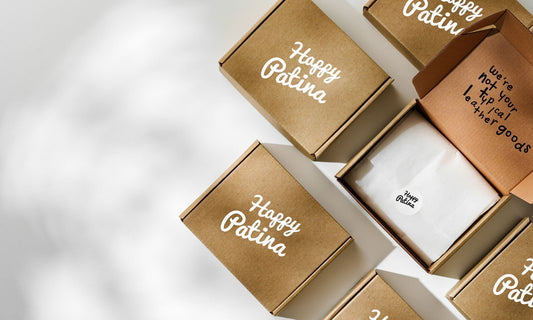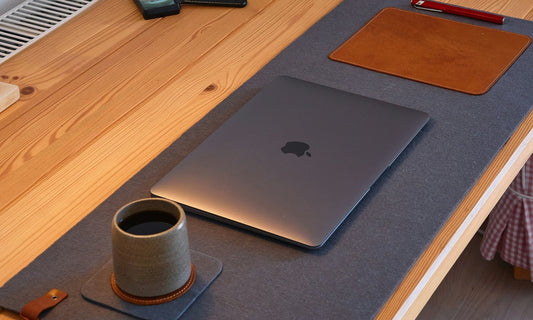
The Return of Craft — Why Authentic Design Still Matters
Oscar ArenasIn an era of automation, speed, and artificial perfection, the word craft feels almost radical. Yet, everywhere we look — from fashion to furniture, from leather goods to digital design — craftsmanship is making a quiet return. This craft revival isn’t nostalgia; it’s necessity.
At HappyPatina, we see it every day: a growing desire for authenticity, for design that feels human again. The world doesn’t need more products — it needs more presence. And that’s exactly what craft provides.
1. The Cultural Shift — From Fast to Slow
For two decades, design culture was driven by speed — fast fashion, fast tech, fast everything. But speed comes at a cost — emotional, aesthetic, and environmental. Consumers began to sense it: the fatigue of the new, the absence of meaning.
Now, a global movement toward slow design is taking root. It values process over production, story over scale, and materials that age rather than expire. The shift isn’t about rejecting progress — it’s about redefining it.
We’ve learned to automate everything — except emotion.
2. The Craft Revival — Data Meets Desire
Industry reports confirm what culture already knows. According to design trend studies by Dezeen, Monocle, and Wallpaper*, searches and social mentions for terms like “craft,” “artisan,” and “slow design” have risen by over 40% in the past five years. Younger consumers, especially those under 40, now equate quality not with brand names but with time, skill, and transparency.
This is not a niche renaissance — it’s a generational redefinition of value. The new luxury is not mass precision; it’s personal imperfection. People want objects that feel alive, that show the mark of the maker, that carry warmth in an increasingly algorithmic world.
3. Authentic Design as Antidote
Design has always been a reflection of culture — and today, authenticity has become its most precious currency. In a landscape dominated by uniformity, true craft feels revolutionary because it offers something algorithms can’t: emotional texture.
Objects made by hand — or at least made with hand intent — carry a rhythm, a signature of care. They remind us that design isn’t just about solving problems; it’s about creating connection.
This explains why more brands, from heritage ateliers to emerging studios, are rediscovering the language of imperfection — celebrating natural materials, limited editions, and visible processes.
Authenticity isn’t aesthetic — it’s attitude.
4. The Slow Design Trend — A Global Perspective
The slow design movement is now influencing everything from interior architecture to digital UX. Designers are seeking calmness, tactility, and sustainability — not as a marketing story, but as a new measure of intelligence.
In Japan, wabi-sabi principles inspire calm imperfection. In Scandinavia, lagom promotes balance through moderation. In Southern Europe, studios like ours reinterpret tradition through refinement — preserving craft not as a museum artifact, but as a living practice.
Across cultures, one truth remains: slow design is not about style. It’s about awareness — the decision to create meaningfully, not endlessly.
5. Why Craft Matters More Than Ever
In a time when digital design dominates, physical craftsmanship reconnects us to the tangible. It reintroduces friction — the good kind — that forces us to pause, notice, and feel.
Craft isn’t opposed to innovation; it informs it. By embracing process and imperfection, designers create products with soul, not just surface appeal. That’s why forward-thinking brands are blending artisan methods with modern tools — merging precision and presence.
At HappyPatina, we see craft as technology in its purest form — human technology. Leather, thread, and time work together to produce something digital design alone never could: warmth.
6. The Psychology of Authentic Design
Research in design psychology shows that people form deeper emotional bonds with objects that show traceable human input. Texture, irregularity, and even minor imperfections trigger trust and empathy — the same feelings we associate with human relationships.
When you hold a handcrafted object, your senses recognize it as alive. It has temperature, scent, and memory. That connection is what makes ownership feel like companionship.
We don’t just buy objects. We adopt them.
7. The Role of Transparency
Authenticity without transparency is performance. That’s why the new craft movement emphasizes visibility — showing not just what is made, but how and by whom.
Consumers now expect traceability: where the leather came from, who stitched it, what process was used. Brands that share this information build deeper loyalty because they replace mystery with meaning.
At HappyPatina, our creative process — from sketch to finish — is open by design. Transparency is part of the craft; it transforms trust into a tangible form of beauty.
8. The Economic Value of Slowness
Slow design is not anti-business — it’s pro-endurance. In a volatile market, timeless products outlast trends, providing stable value over time. They age gracefully, gain emotional worth, and sustain brand equity far longer than disposable items.
In this sense, craft is the new innovation. Not because it’s new, but because it’s necessary — an antidote to the fatigue of the fast.
As global audiences demand depth and durability, the brands that will thrive are those that move slower — but move better.
9. The Future of Craft
The future belongs to design that feels human. AI can replicate form, but not warmth. Automation can scale production, but not meaning. As we enter a new era of material intelligence, craft becomes a compass — a way to ensure progress remains anchored in purpose.
In this future, authenticity is not a niche — it’s the new normal. And brands like HappyPatina exist not just to make objects, but to remind us that care still matters.
Craft isn’t coming back. It never left — we just stopped paying attention.
FAQs
What is the craft revival?
It’s a global return to handmade and human-centered design. People are seeking authenticity and connection in the objects they own and the brands they support.
What defines slow design?
Slow design values quality, emotion, and longevity over quantity. It emphasizes thoughtfulness and a deeper relationship between maker, material, and user.
Why does authentic design still matter?
Because in an age of mass production, authenticity provides meaning. It builds emotional trust and reconnects us to the human side of creation.
Explore More Guides
- Design That Endures — The Beauty of Honest Materials
- The Living Leather Method™ — Our Way of Crafting Timeless Goods
- A Life Well Crafted — The Philosophy Behind HappyPatina
Final Thoughts
The return of craft isn’t a trend — it’s a correction. A collective realization that design without emotion is decoration, and speed without intention is noise.
As the world rediscovers the beauty of honest work and slow creation, authenticity becomes the ultimate innovation. And that’s the foundation of HappyPatina: not to manufacture products, but to craft permanence — objects that age with dignity, and stories that never expire.



